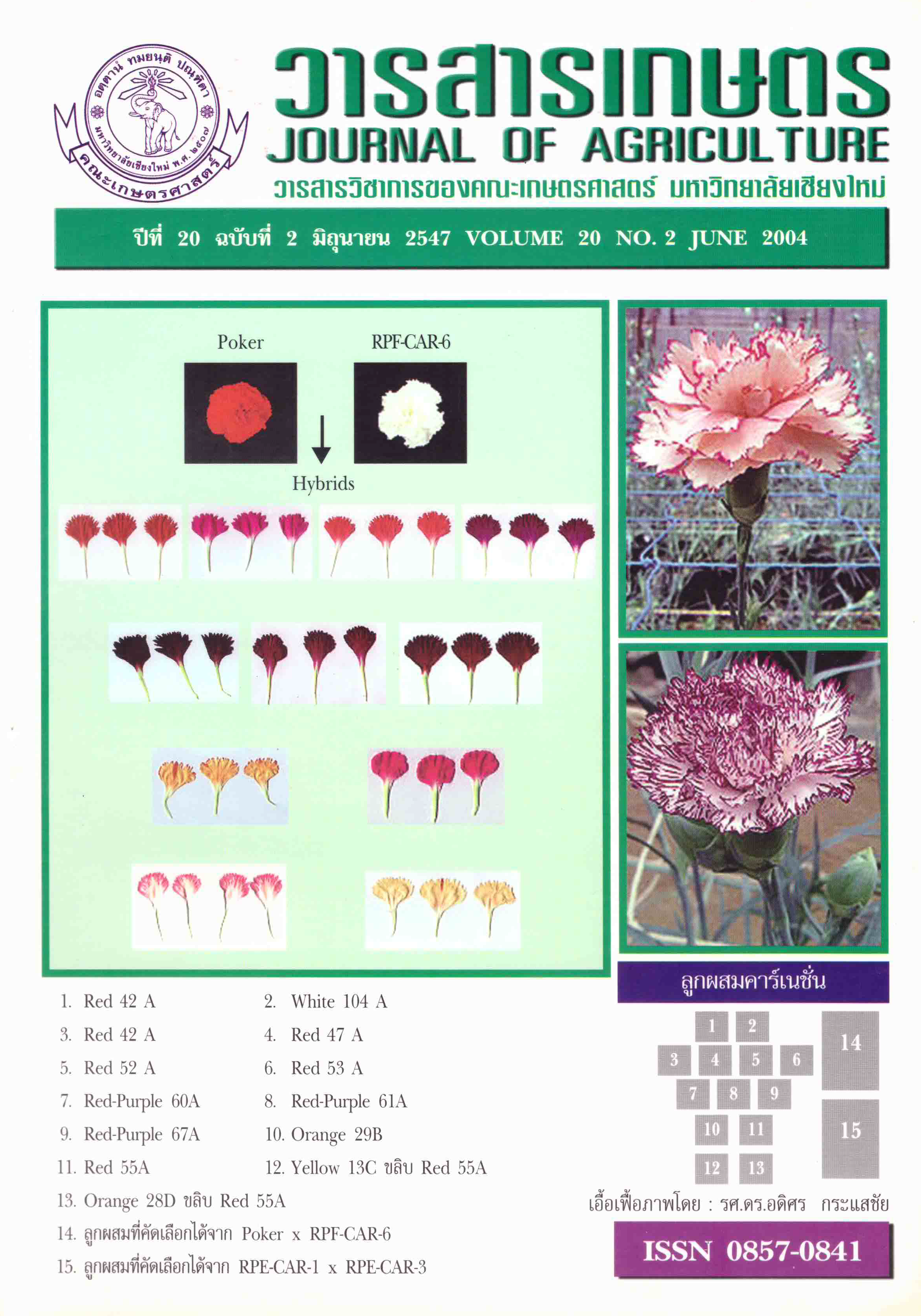ผลของการใช้ความร้อนต่อการเปลี่ยนแปลงโปรตีน ระหว่างการสะท้านหนาวของผลมะม่วงพันธุ์โชคอนันต์
Main Article Content
บทคัดย่อ
การแช่ผลมะม่วงในน้ำร้อนที่อุณหภูมิ 40±1 และ 45±1°ซ นาน 30, 45, 60 และ 75 นาที แล้วเก็บรักษาไว้ที่อุณหภูมิ 5±1°ซ ความชื้นสัมพัทธ์ 90-95% เป็นเวลา 24 วัน พบว่า การแช่น้ำร้อนที่อุณหภูมิ 40±1°ซ ทำให้ผลมะม่วงมีปริมาณโปรตีนที่ละลายได้ในเนื้อเมื่อวิเคราะห์โดยวิธี dye binding มากกว่าการแช่ในน้ำร้อนที่อุณหภูมิ 45±1°ซ การแช่ผลมะม่วงในน้ำร้อนนาน 75 นาที พบว่ามีปริมาณโปรตีนที่ละลายได้น้อยกว่าผลมะม่วงที่แช่ในน้ำร้อนนาน 30, 45 และ 60 นาที เมื่อตรวจสอบรูปแบบของโปรตีนโดยวิธีเอสดีเอส-โพลีอะคริลาไมด์เจลอิเล็กโตรโฟรีซีสความเข้มข้น 10% พบแถบโปรตีนที่เห็นได้ชัดเจนจำนวน 36 แถบในผลมะม่วงทุกกรรมวิธีตลอดระยะเวลาเก็บรักษา ซึ่งโปรตีนเหล่านี้มี น้ำหนักโมเลกุลอยู่ในช่วง 14.00-170.00 กิโลดาลตัน เมื่อวิเคราะห์น้ำหนักโมเลกุลของแถบโปรตีนโดยเครื่อง Gel Documentation and Analysis System พบว่า เมื่อเริ่มต้นการเก็บรักษา ผลมะม่วงชุดควบคุมมีแถบโปรตีนหลัก 18 แถบ ซึ่ง มีน้ำหนักโมเลกุลระหว่าง 16.36-104.32 กิโลดาลตัน ส่วนผลมะม่วงที่แช่ในน้ำร้อนที่อุณหภูมิ 45±1°ซ นาน 60 และ 75 นาทีมีแถบโปรตีนหลักน้อยกว่าชุดควบคุม 1 แถบ ซึ่งเป็นแถบโปรตีนที่มีน้ำหนักโมเลกุลระหว่าง 25.11-26.84 กิโลดาล-ตัน เมื่อเก็บรักษาเป็นระยะเวลา 4 วัน ผลมะม่วงในทุกกรรมวิธีไม่พบว่ามีแถบโปรตีนที่มีน้ำหนักโมเลกุล 16.06-16.36 กิโลดาลตัน แต่มีแถบโปรตีนที่มีน้ำหนักโมเลกุล 23.28-24.01 กิโลดาลตันในผลมะม่วงชุดควบคุมและผลมะม่วงที่แช่ในน้ำร้อนที่อุณหภูมิ 40±1°ซ นาน 30 และ 45 นาทีเท่านั้น ภายหลังการเก็บรักษานาน 8 วัน ผลมะม่วงในทุกกรรมวิธีมีแถบโปรตีนหลักเท่ากันคือ 16 แถบ ซึ่งมีน้ำหนักโมเลกุลอยู่ในช่วง 20.00-116.00 กิโลดาลตัน
Article Details
เอกสารอ้างอิง
วิจิตร วังใน. 2526. มะม่วง. ภาควิชาพืชสวน คณะเกษตร มหาวิทยาลัยเกษตรศาสตร์, กรุงเทพฯ . น. 70-71.
วิจิตร วังใน. 2533. พันธุ์มะม่วง. น. 1-17. ใน ไพบูลย์ ไพรีพ่ายฤทธิ์ (ผู้รวบรวม) การทำสวนมะม่วง. มหาวิทยาลัยเกษตรศาสตร์ วิทยาเขตกำแพงแสน. นครปฐม.
Caprette, D.R. 1997. “Bradford protein assay” [Online] Available http://www.ruf.rice.edu/~bioslabs/ methods/protein/bradford.html ( 17 May 2002 ).
Ferguson, I.B., S. Lurie and J.H. Bowen. 1994. Protein synthesis and breakdown during heat shock of cultured pear (Pyrus communis L.) cells. Plant Physiol. 104 : 1429-1437.
Ferguson, I.B., S. Ben–Yehoshua, E.J. Mitcham, R.E. McDonald and S. Lurie. 2000. Postharvest heat treatments : introduction and workshop summary. Postharvest Biol. Technol. 21 : 1-6.
Hershko, A. and A. Ciechanover. 1992. The ubiquitin system for protein degradation Ann. Rev. Biochem. 61 : 801-807.
Key, J.L., C.Y. Lin and Y.M. Chen. 1981. Heat shock proteins of higher plants. Proc. Natl. Acad. Sci. USA. 78 : 3526-3530.
Laemmli, U.K. 1970. Cleavage of structure proteins during the assembly of the head of bacteriophage T4. Nature. 227 : 680-685.
Leon, D.M. and M.A. Gomez. 2001. Heat shock proteins in refrigerated heat pre-treated mango. Annual Meeting, Section 30B, Fruit and Vegeable Products, New Orleans, Louisiana, USA. [Online] Available http://ift.confex.com/ift/2001/ techprogram/session_900.htm. (9 October 2002).
Lurie, S. and J.D. Klein. 1990. Heat treatment of ripening apples, differential effects on physiology and biochemistry. Physiol. Plant., 78 :181-186.
Paull, R.E. and N.T. Chen. 1990. Heat shock response in field grown, ripening papaya fruit. J. Amer. Soc. Hort. Sci. 115(4) : 623-631.
Sabehat, A., D. Weiss and S. Lurie. 1995. Persistence of heat shock proteins in heated tomato fruit and resistance to chilling injury of the fruit. Acta Hort. 398 : 11-21.
Sabehat, A., D. Weiss and S. Lurie. 1996. The correlation between heat-shock protein accumulation, persistence and chilling tolerance in tomato fruit. Plant Physiol. 110 : 531-537.
Wettern M., H.A. Parag, L. Pallman, I. Ohad and R.G. Kullka. 1990. Ubiquitin in Chlamydomonas reinhardii. distribution in the cell and effect of heat shock and photoinhibition on its conjugate patterns. Eur. J. Biochem. 191 : 571-576.
Woolf, B.A., C.B. Watkins, J.H. Bowan, M. Lay-Yee, J.H. Maindonald and J.B. Ferguson. 1995. Reducing external chilling injury in stored ‘Hass’ avocado with dry heat treatments. J. Amer. Soc. Hort. Sci. 120(6) : 1050-1056.
Woolf, A.B. 1997. Reduction of chilling injuries in stored ‘Hass’ avocado fruit by 38 degrees C water treatments. HortScience. 32(7) : 1247-1254.
Yang, R.F., T.S. Chenge and R.L. Shewfelt. 1990. The effect of high temperature and ethylene treatment on the ripening of tomatoes. Plant Physiol. 136 : 368-372.


